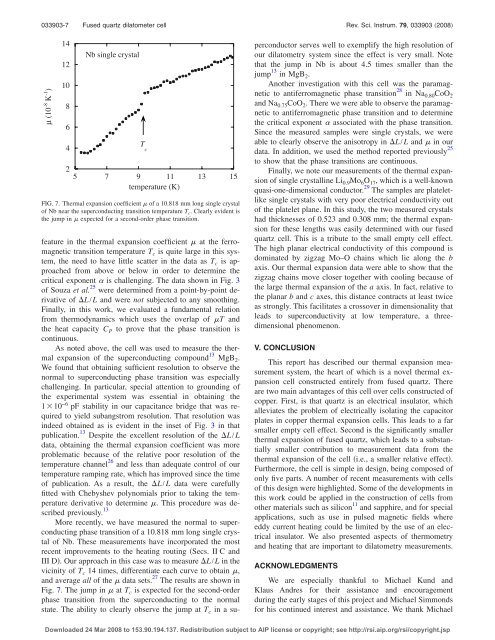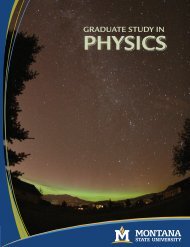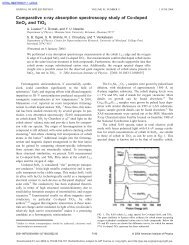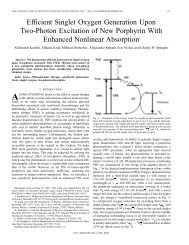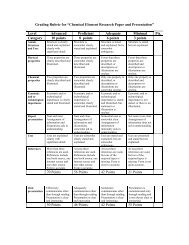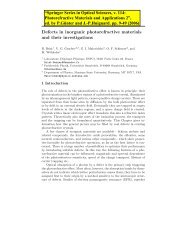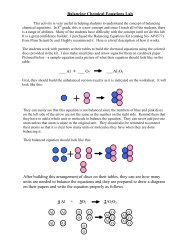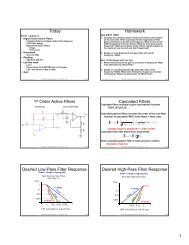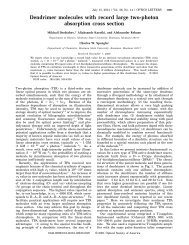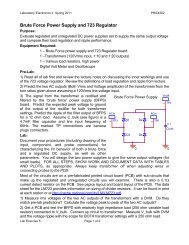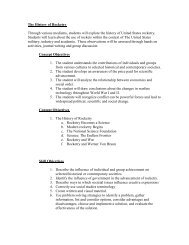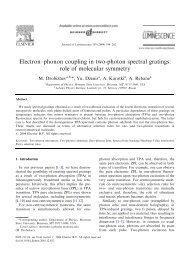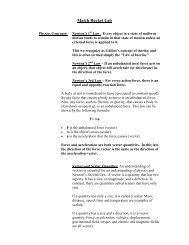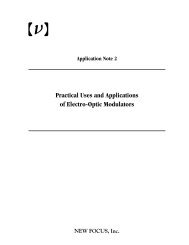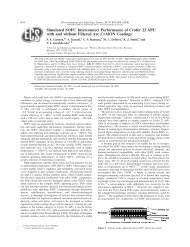Capacitive-based dilatometer cell constructed of fused quartz for ...
Capacitive-based dilatometer cell constructed of fused quartz for ...
Capacitive-based dilatometer cell constructed of fused quartz for ...
You also want an ePaper? Increase the reach of your titles
YUMPU automatically turns print PDFs into web optimized ePapers that Google loves.
033903-7 Fused <strong>quartz</strong> <strong>dilatometer</strong> <strong>cell</strong> Rev. Sci. Instrum. 79, 033903 2008<br />
µ (10 -8 K -1 )<br />
14<br />
12<br />
10<br />
8<br />
6<br />
4<br />
Nb single crystal<br />
T<br />
c<br />
2<br />
5 7 9 11 13 15<br />
temperature (K)<br />
FIG. 7. Thermal expansion coefficient <strong>of</strong> a 10.818 mm long single crystal<br />
<strong>of</strong> Nb near the superconducting transition temperature T c . Clearly evident is<br />
the jump in expected <strong>for</strong> a second-order phase transition.<br />
feature in the thermal expansion coefficient at the ferromagnetic<br />
transition temperature T c is quite large in this system,<br />
the need to have little scatter in the data as T c is approached<br />
from above or below in order to determine the<br />
critical exponent is challenging. The data shown in Fig. 3<br />
<strong>of</strong> Souza et al. 25 were determined from a point-by-point derivative<br />
<strong>of</strong> L/L and were not subjected to any smoothing.<br />
Finally, in this work, we evaluated a fundamental relation<br />
from thermodynamics which uses the overlap <strong>of</strong> T and<br />
the heat capacity C P to prove that the phase transition is<br />
continuous.<br />
As noted above, the <strong>cell</strong> was used to measure the thermal<br />
expansion <strong>of</strong> the superconducting compound 13 MgB 2 .<br />
We found that obtaining sufficient resolution to observe the<br />
normal to superconducting phase transition was especially<br />
challenging. In particular, special attention to grounding <strong>of</strong><br />
the experimental system was essential in obtaining the<br />
110 −6 pF stability in our capacitance bridge that was required<br />
to yield subangstrom resolution. That resolution was<br />
indeed obtained as is evident in the inset <strong>of</strong> Fig. 3 in that<br />
publication. 13 Despite the ex<strong>cell</strong>ent resolution <strong>of</strong> the L/L<br />
data, obtaining the thermal expansion coefficient was more<br />
problematic because <strong>of</strong> the relative poor resolution <strong>of</strong> the<br />
temperature channel 26 and less than adequate control <strong>of</strong> our<br />
temperature ramping rate, which has improved since the time<br />
<strong>of</strong> publication. As a result, the L/L data were carefully<br />
fitted with Chebyshev polynomials prior to taking the temperature<br />
derivative to determine . This procedure was described<br />
previously. 13<br />
More recently, we have measured the normal to superconducting<br />
phase transition <strong>of</strong> a 10.818 mm long single crystal<br />
<strong>of</strong> Nb. These measurements have incorporated the most<br />
recent improvements to the heating routing Secs. II C and<br />
III D. Our approach in this case was to measure L/L in the<br />
vicinity <strong>of</strong> T c 14 times, differentiate each curve to obtain ,<br />
and average all <strong>of</strong> the data sets. 27 The results are shown in<br />
Fig. 7. The jump in at T c is expected <strong>for</strong> the second-order<br />
phase transition from the superconducting to the normal<br />
state. The ability to clearly observe the jump at T c in a superconductor<br />
serves well to exemplify the high resolution <strong>of</strong><br />
our dilatometry system since the effect is very small. Note<br />
that the jump in Nb is about 4.5 times smaller than the<br />
jump 13 in MgB 2 .<br />
Another investigation with this <strong>cell</strong> was the paramagnetic<br />
to antiferromagnetic phase transition 28 in Na 0.80 CoO 2<br />
and Na 0.75 CoO 2 . There we were able to observe the paramagnetic<br />
to antiferromagnetic phase transition and to determine<br />
the critical exponent associated with the phase transition.<br />
Since the measured samples were single crystals, we were<br />
able to clearly observe the anisotropy in L/L and in our<br />
data. In addition, we used the method reported previously 25<br />
to show that the phase transitions are continuous.<br />
Finally, we note our measurements <strong>of</strong> the thermal expansion<br />
<strong>of</strong> single crystalline Li 0.9 Mo 6 O 17 , which is a well-known<br />
quasi-one-dimensional conductor. 29 The samples are plateletlike<br />
single crystals with very poor electrical conductivity out<br />
<strong>of</strong> the platelet plane. In this study, the two measured crystals<br />
had thicknesses <strong>of</strong> 0.523 and 0.308 mm; the thermal expansion<br />
<strong>for</strong> these lengths was easily determined with our <strong>fused</strong><br />
<strong>quartz</strong> <strong>cell</strong>. This is a tribute to the small empty <strong>cell</strong> effect.<br />
The high planar electrical conductivity <strong>of</strong> this compound is<br />
dominated by zigzag Mo–O chains which lie along the b<br />
axis. Our thermal expansion data were able to show that the<br />
zigzag chains move closer together with cooling because <strong>of</strong><br />
the large thermal expansion <strong>of</strong> the a axis. In fact, relative to<br />
the planar b and c axes, this distance contracts at least twice<br />
as strongly. This facilitates a crossover in dimensionality that<br />
leads to superconductivity at low temperature, a threedimensional<br />
phenomenon.<br />
V. CONCLUSION<br />
This report has described our thermal expansion measurement<br />
system, the heart <strong>of</strong> which is a novel thermal expansion<br />
<strong>cell</strong> <strong>constructed</strong> entirely from <strong>fused</strong> <strong>quartz</strong>. There<br />
are two main advantages <strong>of</strong> this <strong>cell</strong> over <strong>cell</strong>s <strong>constructed</strong> <strong>of</strong><br />
copper. First, is that <strong>quartz</strong> is an electrical insulator, which<br />
alleviates the problem <strong>of</strong> electrically isolating the capacitor<br />
plates in copper thermal expansion <strong>cell</strong>s. This leads to a far<br />
smaller empty <strong>cell</strong> effect. Second is the significantly smaller<br />
thermal expansion <strong>of</strong> <strong>fused</strong> <strong>quartz</strong>, which leads to a substantially<br />
smaller contribution to measurement data from the<br />
thermal expansion <strong>of</strong> the <strong>cell</strong> i.e., a smaller relative effect.<br />
Furthermore, the <strong>cell</strong> is simple in design, being composed <strong>of</strong><br />
only five parts. A number <strong>of</strong> recent measurements with <strong>cell</strong>s<br />
<strong>of</strong> this design were highlighted. Some <strong>of</strong> the developments in<br />
this work could be applied in the construction <strong>of</strong> <strong>cell</strong>s from<br />
other materials such as silicon 11 and sapphire, and <strong>for</strong> special<br />
applications, such as use in pulsed magnetic fields where<br />
eddy current heating could be limited by the use <strong>of</strong> an electrical<br />
insulator. We also presented aspects <strong>of</strong> thermometry<br />
and heating that are important to dilatometry measurements.<br />
ACKNOWLEDGMENTS<br />
We are especially thankful to Michael Kund and<br />
Klaus Andres <strong>for</strong> their assistance and encouragement<br />
during the early stages <strong>of</strong> this project and Michael Simmonds<br />
<strong>for</strong> his continued interest and assistance. We thank Michael<br />
Downloaded 24 Mar 2008 to 153.90.194.137. Redistribution subject to AIP license or copyright; see http://rsi.aip.org/rsi/copyright.jsp


